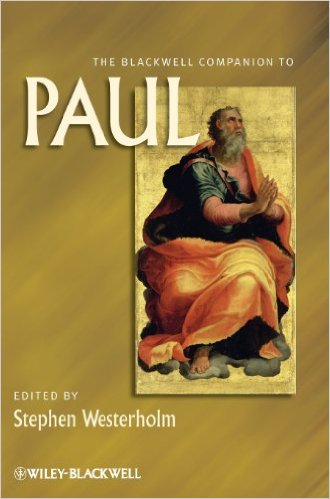 The Blackwell Companion to Paul, ed. Stephen Westerholm (Wiley-Blackwell, 2011), 634 pages.
The Blackwell Companion to Paul, ed. Stephen Westerholm (Wiley-Blackwell, 2011), 634 pages.
Moses and Paul: these two would likely be considered the two most prominent and influential biblical authors who have shaped world civilization through Christianity. (Jesus, of course, did not write anything.) As Westerholm’s Perspectives Old and New on Paul showed us, Paul shaped the Christian theological giants theologically more than any other biblical writer. It is therefore no surprise that Pauline studies continues to be (perhaps) the most active and saturated field in biblical studies today (I’ve never heard of any seminary short on Pauline scholars).
With such an important field of study, there are bound to be several introductory books and textbooks. A couple recent textbooks are excellent introductions to all areas of Pauline study (history, theology, and literary issues), including Bruce Longenecker’s and Todd Still’s Thinking Through Paul and, even better, Rediscovering Paul by Capes, Richards, and Reeves. But a companion or guide to Paul is quite different. These resources will provide up-to-date discussions on scholarly consensuses and contentions. And that is the purpose of The Blackwell Companion to Paul.
This companion is divided into three parts. The first part deals with the typical Pauline issues within Pauline studies. Paul’s relation to the Macedonians, Corinthians, Galatians, Western Asians, and Romans are considered in a chapter each. Riesner introduces the section with a chapter on Pauline chronology, condensing his larger (and thoroughly impressive) monograph on the same topic. Porter writes on Paul in Acts, I. H. Marshall on the Pastorals, Dunn on the gospel, Wagner on Scripture, Gathercole on Christology, Wright on empire, and on and on. This companion to Paul leaves no stone unturned for scholars leading the field.
This book leaves no stone unturned for scholars leading the field. Click To TweetBut this companion is not only interested in strictly biblical studies. It also integrates systematic and historical theology, as well as Paul’s legacy. Part two looks at readers of Paul, beginning with Marcion, spanning through Origen, Augustine, Calvin, Barth, recent continental philosophers, modern Jewish readers, etc., finally concluding with African readers.
Part three is the shortest, containing chapters on Paul’s legacy in art, literature, theology on sin and the fall, the Spirit, ethics, and the church. These chapters alone are worth the read because they give an impression of the various ways Paul has left his legacy, which exposes a variety of lenses that have been put over Paul’s writings. Such exposure helps us to reconsider our own lenses with which we read Paul’s letters.
The chapters—37 in total—are obviously too many to summarize. Each chapter spans around 10-15 somewhat large pages of small-ish text. They are therefore somewhat lengthy, but not entirely comprehensive. These chapters packed with many references, but only of a quite general kind. There is no detailed exegesis, nor is there space to unpack issues in serious detail. A broad sweep of the pressing issues is all the authors can manage in these chapters.
But this does not render the book useless. On the contrary, students may gain a quick view of the landscape on any one issue and build further study on that foundation. I would suggest that this resource would be most useful to the student who has already read a textbook on Paul (perhaps one of the ones mentioned above) and who now is seeking either to gain a better understanding of academic issues involved in Pauline studies, or who is researching a specific topic in Pauline studies. This companion is a good place to start with researching topics such as Paul and empire, chronology, and the like.
But how does it fare against other similar works? Dictionary of Paul and His Letters is the strongest competitor, with just as impressive a lineup of scholars and more total pages and topics. DPL is a “dictionary,” though (more like an encyclopedia, really), and reads more like a stripped down version of the facts, whereas the Blackwell Companion reads more like essays. In this sense, the two volumes are complementary and should be owned together. DPL may be your first go-to resource to be acquainted quickly with any issue, while the Companion could be consulted afterward.
A handbook has also been published in German by Mohr Siebeck, Paulus Handbuch. I have not had the chance to get ahold of a copy of this work, and I cannot find a table of contents for it anywhere online. If anyone knows what is in this handbook, please feel free to comment below, especially if you have a link to the table of contents. I suppose it covers much the same ground as this companion and would therefore be a complement from a more thoroughly German perspective.
In sum, this companion deserves a place on the shelf of every student, pastor, and scholar. It will be of more use to the former two, but even the scholar may reap some insights from this volume, especially in the sections that are more foreign to one’s field. I highly recommend this work.
Find it here on Amazon.

